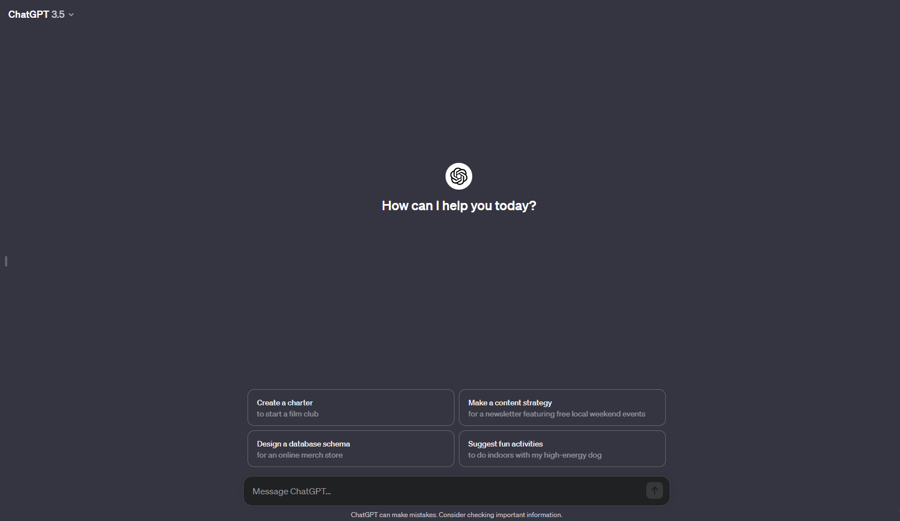
Artificial intelligence (AI) is one of the most talked-about subjects currently. But what exactly does it entail, and how can we use it when creating and administrating online courses? In essence, artificial intelligence refers to computer systems or software that can undertake tasks that typically require human intelligence. For instance, AI can generate images and audio and translate languages.
In addition, artificial intelligence also offers many possibilities for creating the structure, titles, paragraphs, tasks, questions, and summaries of online courses.
The Role and Implementation of Artificial Intelligence in Online Course Design
AI tools are like assistants that can help in the planning and development process of online courses. Designing and implementing course content can be more accessible and more versatile with them. For example, AI language models like ChatGPT or Copilot are text-based tools that can help create engaging and high-quality online course content.

Screenshot of ChatGPT 3.5 Artificial Intelligence (AI) Tool.
These tools can provide inspiration, suggestions, and assistance in planning online courses, creating content, and making summaries. This blog post discusses text-based AI tools such as ChatGPT or Copilot.
Providing unambiguous instructions is essential when preparing to use AI in course design. Here are some tips for using AI:
- Define a Clear Goal: State what you want the AI to do at each stage.
- Text Style and Length: Specify the type of content you want the AI to produce, such as text length, style, or tone.
- Simple Language: Use clear and understandable language in instructions, avoiding complex sentence structures.
- One Task at a Time: Each prompt should focus on one main task or question to ensure AI has a clear focus.
- Keywords: Use keywords that guide AI in the desired direction.
- Step by Step: Break down complex tasks into smaller steps and request step-by-step progress from AI.
- Provide Context if Necessary: Provide additional information to help AI understand the given task better.
- Use Examples: Show AI what you want it to do.
The Role of AI in Content Creation for Online Courses
The use of AI in developing online courses extends beyond designing the course structure and objectives. It can assist in generating course content that is customized to match the needs and preferences of the learners. AI-generated content can be part of your course material or inspire your content creation. AI offers numerous benefits for planning and implementing course content. Some of these benefits are as follows:
- Saves Time and Effort: AI can create content quickly and efficiently, saving you from having to write or produce everything yourself.
- Adds Variety and Diversity: AI can provide various formats and styles for content creation, enabling learners to practice and learn differently.
- Improves Content Quality and Readability: AI can check and correct the grammar and spelling of your content, ensuring that the content is of high quality and error-free.
Let's look at how AI can be utilized in designing online courses.
Towards Successful Online Course Design with AI
Online course design begins with defining the course goals, target audience, and structure. These are essential aspects that determine the nature of the online course and how it will be implemented. AI can significantly help in this phase by providing ideas and feedback on questions related to course design. For example, you can ask AI questions such as:
- "What are the essential characteristics of a good online course?"
- "What key things should be taught in an online course?"
- "What questions or challenges might the target audience of the online course have?"
Based on the responses provided by AI, you can create a clear and consistent structure for your online course. You can divide your course into chapters or learning path steps corresponding to your learning objectives and covering key topics.
Utilize AI to Create a Content Plan for Your Online Course

Creating an online course can be challenging, especially if you are still determining what content should be included and how it should be structured. Here are some tips on how to use AI to plan your online course to get started in the planning process:
Topic and objectives: Tell the AI tool what the topic and aim of the online course are. It will then provide you with a proposal for the structure and content of the online course.
For example:
Create a structure and content for the online course based on the following instructions:
Topic: Fundamentals of Digital Marketing
Objective: Learn the key digital marketing concepts and gain a strong foundation for starting digital marketing.
Target audience: Individuals with no previous experience in digital marketing.
AI can be a valuable tool to discover new ideas and topics for the content of your online course. For instance, you can inquire about the AI tool by asking questions like "What would be an interesting topic for a module in the online course teaching the principles of company cybersecurity?" or "What keywords should I include in the third chapter of my online course, where I explain the basics of search engine optimization?"
Harness AI in Generating Engaging Titles
Generating engaging titles may seem challenging, but AI can help create memorable titles related to the online course topic. Instead of sticking to simple titles like "Chapter 1", ask AI for suggestions for titles that clearly and interestingly convey the online course topic. For example, if the course topic is café onboarding, AI could suggest titles like:
- Café Employee's ABC: Learn Everything About Coffee, Customer Service, and Hygiene"
- "Welcome to the Café World: Shine in Your New Job with These Tips"
You can ask AI for title suggestions using questions like these:
- "What are some good titles for the first chapter of my online course, where I teach the basics of creating online courses?"
- "What are some good subheadings for the second chapter of my online course, which covers construction site safety?"
Checking and Improving Course Content with AI

Course content is essential to the learning experience – good course content should be clear, informative, engaging, and error-free. You can check and improve course content in various areas using AI.
If you need feedback on your online course, you can ask AI for help. Simply ask, "Is this chapter of the online course [topic] clear and informative?" AI will evaluate your course material on various factors such as understandability, comprehensiveness, engagement, and grammatical correctness. Additionally, you can ask AI for suggestions to improve your course content. For example, you can say, "Can you provide tips for the content of the online course on [topic]?"
AI will offer suggestions to enhance your course content, which may include:
- Add images, videos, examples, or exercises to make the topic more illustrative and engaging.
- Tell a story related to the topic to spark learners' interest.
- Use clear and understandable language suitable for online learners and the topic of the course.
- Make sure to review the course for spelling, grammar, and punctuation errors to ensure it is error-free and easy to read.
You can also optimize the order of chapters in the online course with AI. For example, AI can analyze learning objectives, topics, subtopics, relationships, and dependencies. Based on the analysis, it can suggest the best possible order for the chapters that support learners' learning. For example:
"The topic of the online course is digital marketing.
The online course topics are digital marketing, search engine optimization, email marketing, social media, search engine marketing, digital marketing implementation, digital marketing monitoring and optimization, and digital marketing strategy.
Organize the topics logically and consistently from the learner's perspective."
AI could suggest the following order for the topics:
- Digital Marketing: Introduction to digital marketing and its importance in modern business.
- Digital Marketing Strategy: Learn how to plan and execute an effective digital marketing strategy that aligns with your business goals and meets your audience's needs. Discover how to choose and utilize various digital marketing channels and tools, including websites, blogs, social media, email, search engines, and advertisements.
- Search Engine Optimization: Learn how to improve website visibility and attract visitors with Search Engine Optimization.
- Search Engine Marketing: Learn how to create and manage effective keyword advertising campaigns that increase website traffic and conversions.
- Email Marketing: Learn how to build and maintain email lists that enable direct and personalized communication with customers and potential customers.
- Social Media: Learn how to effectively use social media platforms, such as Facebook, Twitter, Instagram, and LinkedIn, to boost brand awareness, engage with your audience, and increase sales.
- Digital Marketing Monitoring and Optimization: Learn how to measure and analyze digital marketing results across different channels and tools and make necessary changes to improve performance and achieve goals.

Planning Engaging and Diverse Tasks for an Online Course with the Support of AI
AI can also support the planning of tasks for an online course. Course tasks should contribute to achieving key concepts and learning objectives related to the topic. You can input keywords, phrases, or questions related to your online course topic to AI, which can suggest more questions. Here are some examples of task prompts you can give to AI:
- "Design tasks for the online course that test students' knowledge of café onboarding. Tasks may include multiple-choice and fill-in-the-blank questions."
- "Please create ten multiple-choice and ten open-ended questions related to digital marketing for an online course. The keywords for the online course are email marketing, social media, search engine optimization (SEO), and search engine marketing (SEM). The target audience of the online course has a medium level of knowledge."
- "The key concepts of the online course are security, threat, attack, firewall, malware, phishing, privacy, multilayered security, identification and authentication, vulnerability testing, and security updates. The learning objective is for students to thoroughly understand online security threats and attacks and master the security techniques and methods to protect the organization's information systems. The learners of the online course are of medium level. Create the following tasks for the online course: multiple-choice, open-question, completion, and order. Make three tasks for each."
Ensuring the Responsible Use of AI in Online Course Design
AI can be used to support the production of high-quality and engaging online courses, but AI cannot replace humans; it serves as a tool that requires human guidance and judgment. When considering the use of AI in online course design and creation, it is essential to keep the following in mind:
- AI cannot replace human experience and intuition. You must interpret and apply the responses provided by AI in your context.
- You must check and, if necessary, correct the responses provided by AI to ensure their accuracy and suitability.
- AI needs to be provided with sufficient background information and clear instructions to produce more accurate and relevant responses.
- You must ensure that you use AI responsibly and ethically and comply with laws and regulations. For example, you can study the ethics of AI in a course offered by the University of Helsinki.
- AI is learning – it can improve its performance and learn new things if you provide feedback and correct its mistakes. This helps AI better understand your goals and needs.
- AI is versatile – it can use different sources and methods to generate text, which can enrich your content. You can use the texts and ideas AI suggests as inspiration or modify them.
- AI is responsible – it follows the instructions and limitations you provide. However, you should be careful not to provide AI with information you do not want to share, which may pose a risk to you or others.
If you want to learn more about the basics of AI, you can take the Elements of AI online course.
AI Cannot Replace the Crucial Role of a Course Creator
AI tools are not intended to replace you but to help you create quality, engaging content. AI tools can provide you with ideas, tips, and feedback, but you are the one who decides what is taught in your courses and how. However, AI can make online course design faster and more diverse, improving learners' motivation and learning outcomes.